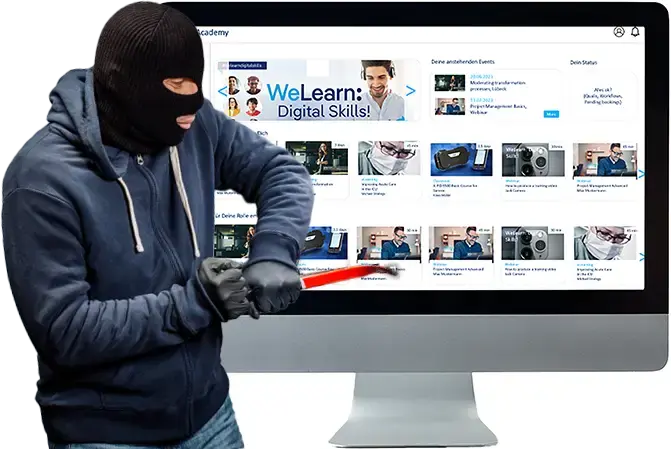Secure Data Transmission in LMS: A Guide to Encryption & API Security
How Strong Encryption Protects Your LMS from Cyber Threats

In an increasingly digital learning environment, data security is paramount. Learning platforms, particularly Learning Management Systems (LMS), store a wide array of sensitive information—from personal user data to learning progress and exam results. Without adequate security measures, this information is vulnerable to attacks. One of the most critical lines of defense is encryption.
On this page, we provide detailed insights into the encryption techniques essential for an LMS, how they are implemented in practice, and what you should look for as a potential customer when choosing a secure platform. The following sections offer valuable information and concrete advice to help you make informed decisions when selecting an LMS.
1. Why Encryption is Essential for Learning Platforms
Data security in an LMS is not only important for protecting information but also for ensuring user trust and legal compliance. A modern LMS must safeguard the data of its learners and the content delivered through the platform.
Why encryption matters:
- Protection of sensitive data: Learning platforms process personal and confidential information, such as user profiles, learning progress, certificates, or exam data. This information must be protected from cyberattacks. Strong encryption ensures that even in the event of a data breach, unauthorized individuals cannot access the information.
- Compliance with legal requirements: Strict data protection regulations like GDPR in Europe and the CCPA in the U.S. place the responsibility on companies to securely store and transmit user data. Strong encryption helps meet these legal requirements, avoiding costly fines or legal action.
- Avoiding reputational damage: Security breaches can cause significant harm to a company’s reputation. Customers and users need to be confident that their data is secure when using an LMS. Companies that prioritize secure platforms position themselves as trustworthy and responsible.

2. Basic Encryption Techniques for LMS
There are various encryption technologies that can be used to protect the data within an LMS. Each technique has specific strengths and use cases.

Key encryption techniques:
- Symmetric encryption: In symmetric encryption, the same key is used for both encrypting and decrypting data. This method is particularly efficient and well-suited for encrypting large amounts of data stored within the LMS. An example is the AES (Advanced Encryption Standard) algorithm, often used to encrypt data in databases. However, the key must be securely stored and distributed.
- Asymmetric encryption: This method uses a pair of keys—a public key and a private key. The public key is used to encrypt data, while the private key is used to decrypt it. A major advantage is that the public key can be freely distributed, while the private key remains secure. This is ideal for encrypting data during transmission, such as during logins or API usage. The RSA algorithm is commonly used in this context.
- Transport Layer Security (TLS): TLS is the standard for securing data transmission over the internet. It protects communication between the user’s browser and the LMS server. Data transmitted over HTTPS is secured by TLS, which is crucial to ensure that login credentials or other sensitive data cannot be intercepted during transmission.
- End-to-End Encryption: End-to-end encryption ensures that data is encrypted from the sender to the recipient. Only the recipient can decrypt the data. While this method is common in messaging systems, it can also be valuable in LMS applications, particularly when exchanging sensitive data between two parties, such as certificates or exam results.
3. Encryption for Interfaces and API Communication
LMS platforms often work with various systems to exchange data, whether through APIs (Application Programming Interface) or automated processes like batch jobs. To keep these connections secure, specific encryption techniques must be employed.
OAuth 2.0 and OpenID Connect:
OAuth 2.0 is a widely used protocol for secure authorization over APIs. It allows applications to access data without sharing login credentials. OpenID Connect builds on OAuth 2.0 by adding a secure authentication layer. This is particularly important to ensure that only authorized applications and users can access the LMS interfaces.
Encryption of API connections:
APIs that transfer data between different systems should always be encrypted to maintain data integrity and confidentiality. TLS ensures that data is not intercepted or altered as it moves between systems. This applies to both REST APIs, which transmit data in JSON or XML formats, and older SOAP-based APIs.
Security for automated jobs:
Many LMS platforms rely on automated processes (e.g., data exports, reporting) to streamline workflows. These jobs, often running in the background, must also be secure. This requires encrypting the data processed in these jobs and securely managing access rights.
4. How to Recognize Secure Encryption
For potential customers, evaluating the true security of an LMS can be challenging. However, there are some clear indicators that signal strong encryption and inspire confidence.

Security features of a secure LMS:
- SSL/TLS certificates: One of the simplest and most visible signs of secure data transmission is a valid SSL/TLS certificate, indicated by the "https://" prefix in the URL and the padlock icon in the browser. These certificates ensure that communication between the user and the platform is encrypted and protected from eavesdropping.
- Security standards and certifications: Recognized security certifications such as ISO 27001, SOC 2, or BSI IT-Grundschutz provide an additional layer of assurance. These certifications demonstrate that the LMS provider adheres to strict security guidelines and undergoes regular audits to maintain these standards.
- Penetration tests: Providers that regularly conduct penetration tests with independent security firms can identify and fix vulnerabilities in their platforms early on. Penetration tests simulate real-world cyberattacks to uncover weaknesses in the system’s implementation.
5. Implementation and Integration: How Difficult is It to Implement?
Implementing secure encryption techniques in an LMS requires technical expertise and planning. However, many tools and technologies make this process easier.

What you need to know about implementation:
- Technical resources: Integrating modern encryption techniques requires specific technical expertise. Platforms that offer encryption “out of the box” reduce the burden on the company’s technical teams. Still, careful planning and adaptation to the specific needs of the learning platform are necessary.
- Costs and time commitment: Implementing secure encryption standards may require upfront investments in technology and skilled personnel. The time investment is also notable, particularly when integrating encryption into existing systems. However, the long-term benefits outweigh these costs, as security incidents and legal issues are avoided.
- Best practices: A phased implementation, starting with encrypting key interfaces and data storage, minimizes the risk of security gaps and makes the transition smoother. Close collaboration with security and IT teams ensures the best encryption solution is chosen for your needs.
6. Testing and Validation: How is Security Verified?
Security measures are only effective if they are continuously tested and verified. Regular validation through testing is essential for maintaining the security of an LMS.
Security testing methods:
- Automated security testing: Tools such as OWASP ZAP (Zed Attack Proxy) or SSL Labs are useful for performing automated security checks. These tools scan the platform and API connections for vulnerabilities, such as weak TLS configurations or insecure encryption protocols.
- Regular updates: Encryption standards evolve. To ensure that your LMS is protected against the latest threats, encryption algorithms should be updated regularly. Outdated standards like SSL or old versions of TLS should be avoided as they are vulnerable to attacks.
- External audits: An independent security audit by specialized companies provides an additional layer of security. These audits are often more comprehensive than internal tests and consider a wide range of potential attack vectors.
7. Best Practices for Data Security in Learning Platforms
In addition to encryption, there are several other measures that can significantly enhance the security of an LMS. These should be part of the overall security strategy.
Key security measures:
- Multi-factor authentication (MFA): MFA adds an extra layer of protection for user accounts by requiring a second authentication factor in addition to a password. This can be a temporary code sent via SMS or biometric authentication (fingerprint, facial recognition). Even if a user’s password is compromised, MFA keeps LMS access secure.
- Pseudonymization of user data: An additional security measure involves pseudonymizing personal information, replacing it with anonymous or partially anonymous values. Should a data leak occur, the information cannot be directly traced back to an individual. This measure is particularly important for GDPR compliance.
- Backups and recovery: An effective backup strategy should not only focus on regularly securing data but also ensuring that the backups themselves are encrypted. This keeps information protected in the event of a system failure or a cyberattack. Regular tests of the recovery processes should also be conducted to ensure data can be quickly and reliably restored in an emergency.
8. Common Challenges and How to Overcome Them
Despite all precautions, there are certain challenges when implementing encryption technologies that companies should be aware of. However, these challenges can be overcome with the right strategies.
Typical challenges:
- Performance impact: Encryption algorithms require additional computing power, which can negatively impact the speed of an LMS. This is particularly problematic when dealing with large volumes of data or a high number of concurrent users. However, modern algorithms like AES-256 are optimized to strike a good balance between security and performance. Hardware acceleration for encryption can also minimize performance issues.
- Misconfigurations: One of the biggest risks to a system’s security is improper configuration. Even the most secure encryption techniques are of little use if not properly set up. Thorough documentation and regular security reviews are essential. A common misconfiguration is using outdated SSL/TLS protocols, which are now considered insecure.
- Protection from man-in-the-middle attacks (MITM): In a MITM attack, an attacker intercepts the communication between two parties. Such attacks are especially possible when insecure connections or outdated encryption protocols are used. TLS and correctly implemented certificates are the best protection against such attacks, ensuring that the data traffic between the user and the server cannot be tampered with.
9. FAQ - Frequently Asked Questions
- What is the best encryption technique for an LMS?
AES-256 is currently one of the most secure algorithms for data encryption and is used globally for sensitive information.
- How long does it take to implement secure encryption techniques?
The implementation time depends on the complexity of the system but can typically be completed within a few weeks, especially when using standard solutions.
- Can encryption impact the performance of my learning platform?
Yes, encryption requires additional computing power, which can lead to performance losses. However, modern encryption methods like AES-256 are optimized to minimize the impact.
- How often should an LMS provider review security measures?
Comprehensive audits and penetration tests should be conducted at least annually. Critical security updates and patches should be applied immediately once they become available.
10. Conclusion
Choosing an LMS with strong encryption techniques is essential for ensuring data privacy and security. From secure data transmission via APIs to regularly reviewing encryption methods, all of these measures help defend against threats. Potential customers should look for these security features when selecting an LMS and choose a platform that offers comprehensive protection.
Choosing the Best LMS for Your Business
When deciding on an LMS, prioritizing data protection and security is crucial. By following established guidelines, obtaining relevant certifications, and implementing technical safeguards, businesses can ensure their learning platforms meet top standards and protect learners' information.

Contact us now for a comprehensive consultation and learn how our platform uses state-of-the-art security measures to protect your data.
Send us your Requirement Profile and take advantage of our Free Security Assessment to find out how our Learning Management System TCmanager® meets your needs.
Request a demo today to get a glimpse of the security features of our LMS.

About Us
Since 1998 SoftDeCC is working closely with major training centers and academies. This results in a unique experience with training requirements.
Our Learning Management System TCmanager® is designed to adjust to individual corporate learning processes and address evolving challenges. More...

Free Consultancy
Discuss your Training Challenge with us.
Call +49 (0)89 / 309083930 to arrange for your free consultancy.
.webp)






